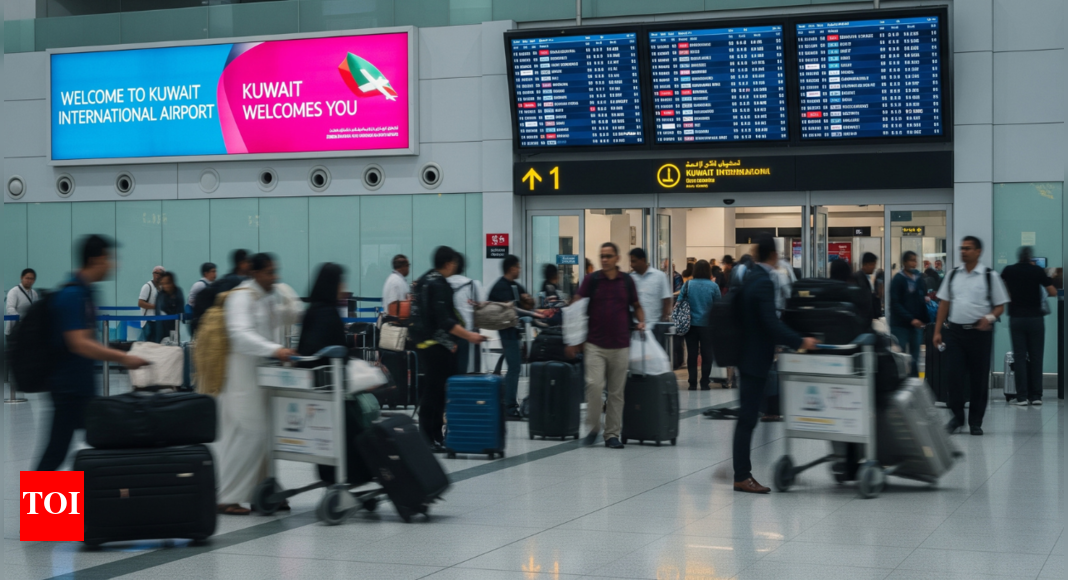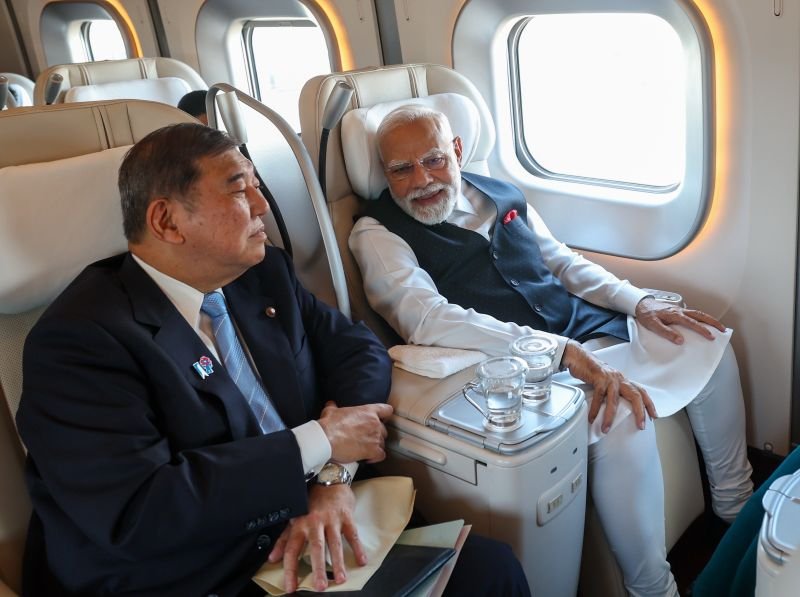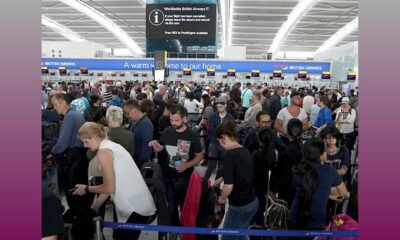Travel Guides & Articles
Indian Travel Vlogger Makes Hadzabe Tribe In Africa Try Rasgulla For 1st Time And Then… | WATCH | Viral

Indian Travel Vlogger Makes Hadzabe Tribe In Africa Try Rasgulla For 1st Time (Image Source – @roamingvinu/Instagram)
A travel vlogger from India has gone viral after making the famous Hadzabe tribe, residing in Northern Tanzania, Africa, try Rasgulla—a sweet delicacy from India—for the first time. The whole experience, captured on video, has since been making waves on social media. The internet is both shocked and curious about the video.
The video was shared on Instagram by a user identified as Vinod Kumar, an Indian travel blogger who also runs a YouTube channel named ”Roaming With Vinu.” The clip is part of a longer video he uploaded on YouTube, where he shares his experience interacting with the tribe and making them try Indian chai, Parle – G biscuits, and Rasgulla. The Instagram portion of the video is captioned, “Hadzabe hunter enjoy first time Indian rasgulla.”
In the video, Vinod can be seen putting a Rasgulla in a small cup-like container and handing it to one of the tribe members. As the tribe member tries the Rasgulla and drinks the chasni (the sugar syrup in which the Rasgulla is dipped), he jumps in excitement and happiness. It appears the man loved the Rasgulla so much that he starts dancing and singing in his own language.
The video has since gone viral, garnering over 1 lakh views, more than 1,000 comments, and over 3 million views overall. Reactions have been varied, including one user writing, “This is me when I used to eat AMUL MILK POWDER in my childhood!” Another remarked, “Aaw, that sugar syrup made him happy.” One hilariously added, “Mera dost raj aesa hi khush hota h jab mai usse 5 rs ka samosa khilata hu.” Another commented, “Bro loves it. His dance spoke a thousand words.”
Travel Guides & Articles
Kuwait’s new travel rule for expats: Leaving before your approved leave? What every expat worker must know | World News

Planning to fly out before your official leave starts? You could be denied at the airport. As Kuwait enforces a mandatory exit permit system for private sector expatriates, aligning your travel dates with employer-approved leave has become critical. Introduced on July 1, 2025, the new rule reflects Kuwait’s broader push for labor regulation and digital oversight through the Kafala-linked system. Here’s a fullbreakdown of what the new policy entails and how it impacts expatriates under Article 18 residency.
Travelling before official leave begins? Exit may be denied
Under Kuwait’s new exit permit regulation, expats in the private sector (Article 18 residency holders) must obtain employer-approved electronic travel authorization before departing the country, even for routine vacations. The process is handled through the Sahel app, and permits must be requested between 7 days and at least 24 hours before travel. A critical requirement: The departure date mentioned in the travel permit must match the actual date of departure, and it must not precede the start of officially approved leave. For example, if your HR department has approved your leave to start on Saturday, but you attempt to travel Thursday night, the exit permit will not be validated at immigration. The system will flag this as a violation, and you may be stopped from boarding your flight. To avoid this:
- Speak with your employer or HR to adjust your leave dates to align with your intended departure.
- Ensure that the exit permit application reflects the actual travel date.
- Plan the permit request in advance, keeping within the 7-day to 24-hour window prior to travel.
- Understand that Friday is generally not deducted from your annual leave, which may affect the leave calculation and dates in the permit system.
Exit permit system officially launched on July 1, 2025
The mandatory electronic exit permit system officially launched on Tuesday, July 1, 2025, for all private sector expatriates covered under Article 18 of Kuwait’s Foreigners’ Residence Law. The system is overseen by the Public Authority for Manpower (PAM) and is part of Kuwait’s broader push toward digital transformation and labour market regulation. Key facts at launch:
- The platform saw over 36,000 applications within hours of going live, indicating strong employer and employee response.
- The exit permits are processed via the Sahel mobile application or the Ashal Manpower Portal.
- Although the process is digital, final approval rests with the employer (or “kafeel”).
This rule applies not just to permanent departures but also to short-term travel or vacations outside Kuwait. Any private sector expatriate or dependent under Article 18 must obtain this permission before attempting to leave the country.
Why was this rule introduced?
Kuwaiti authorities have outlined several reasons for enforcing the exit permit system:
- Prevent illegal departures from the country.
- Ensure contractual obligations (e.g., pending salaries, loans, or duties) are fulfilled before travel.
- Combat labor market abuses, including:
- Employees absconding without notice.
- Visa trading and irregular recruitment practices.
The exit permit system provides real-time monitoring of expatriate movement, aiding the government in identifying and acting against such violations.
Reinforcing the Kafala sponsorship framework
The introduction of exit permits is closely linked to the Kafala (sponsorship) system, a long-standing legal framework across Gulf countries that ties a migrant worker’s residency status directly to their employer. Under this system, employers, who act as sponsors, hold significant authority over the legal and administrative aspects of a worker’s stay, including their ability to travel. The current exit permit policy reinforces this dynamic by giving sponsors broad control over whether an employee can leave the country, even temporarily. While several Gulf Cooperation Council (GCC) countries have taken steps to reform or dismantle parts of the Kafala system in recent years, Kuwait’s implementation of the exit permit marks a clear move toward reasserting employer oversight within the labor framework. The Public Authority for Manpower has stated that the permit system aims to:
- Strengthen oversight by tracking expatriate exits.
- Ensure balanced rights between employers and employees.
- Reduce labor violations, such as undocumented exits or failure to settle obligations.
- Deter illegal visa trading, thereby tightening labor market regulations.
Travel Guides & Articles
Modi, Ishiba travel from Tokyo to Sendai in bullet train

Prime Minister Narendra Modi joined his Japanese counterpart Shigeru Ishiba to travel on a bullet train from Tokyo to Sendai on Saturday.
Sharing images of his train travel, Modi wrote on X: “Reached Sendai. Travelled with PM Ishiba to this city on the Shinkansen.”
Ishiba also shared images of the travel on his X page.
According to the Japanese government’s website, the Shinkansen (lit. new trunk line), Japan’s high-speed rail, celebrated its 50th anniversary in 2014, having opened for service between Tokyo and Osaka in 1964.
Marking a significant safety milestone, Shinkansens have now operated for over 50 years, more than 18,000 days, without a single passenger casualty.
Narendra Modi is currently on a two-day visit to Japan from 29 August to 30 August.
He is attending the 15th India–Japan Annual Summit.
This is the Prime Minister’s eighth visit to Japan.
Modi attended the 15th India–Japan Annual Summit in Tokyo on Friday.
PM Narendra Modi on Friday pitched India as a destination for Japanese business to invest and said the capital not only grows in the South Asian nation but also multiplies.
Addressing the India–Japan Economic Forum in Tokyo, Modi, who arrived in Japan earlier in the day, said: “Japan has always been a key partner in India’s growth journey. Whether it’s metros, manufacturing, semiconductors, or start-ups, our partnership in every area reflects mutual trust.”
“Japanese companies have invested more than $40 billion in India. In the last two years alone, there has been private investment of $13 billion. JBIC says India is the most ‘promising’ destination. JETRO says 80 percent of companies want to expand in India, and 75 percent are already profitable,” he said.
“Which means, in India, capital does not just grow, it multiplies!” the PM said.
India’s bullet train journey
The E10 Shinkansen, derived from Japan’s ALFA-X experimental train, will be jointly manufactured in India under an agreement in principle between the two countries.
The collaboration will deepen economic cooperation and build on the ongoing 508-km Ahmedabad–Mumbai high-speed rail project.
The E10 Shinkansen is a high-speed rail system, akin to those running in countries such as France—India’s first choice for collaboration on the project. Nations like China, South Korea, Turkey, Spain, Germany, Italy, the Netherlands, and Belgium also operate such services.
Commonly known as a ‘bullet train’, this service requires dedicated tracks and must maintain speeds above 250 km per hour.
The Mumbai–Ahmedabad High-Speed Rail (MAHSR) project was launched in September 2017, when Modi and then Japanese Prime Minister Shinzo Abe laid the foundation stone at Sabarmati in Gujarat.
This followed four years of feasibility studies by Indian Railways and Japan’s International Cooperation Agency. Two years later, a memorandum of understanding was signed, with Japan committing to fund 80 per cent of the project through a soft loan. Progress, however, was stalled for several years.
Construction has since accelerated. The first stretch in Gujarat is scheduled to open in 2027, with the full 508-km route expected to become operational by 2028, cutting travel time to two hours and seven minutes.
Back in 2009, five other high-speed rail corridors—including Pune–Ahmedabad and Delhi–Amritsar via Chandigarh—had been shortlisted.
Travel Guides & Articles
Essential tips for monsoon travel lovers

Monsoon in India isn’t just a season—it’s a feeling. Misty hills, roaring waterfalls, and the earthy scent of rain make it one of the most enchanting times for travellers. Lush landscapes, romantic showers, and refreshing escapes offer a chance to slow down, breathe, and soak in nature’s beauty. Exploring rainforests, beach towns, or hilly cities during this season can be a magical experience, but careful preparation is key due to unpredictable weather and high humidity.
1. Use Waterproof Sunscreen
Even on cloudy, rainy days, UV rays can damage your skin. Monsoon clouds can reflect sunlight, intensifying UV exposure. Opt for a lightweight, gel-based, water-resistant sunscreen that won’t clog pores. Reapply every three hours, especially after sweating, swimming, or prolonged outdoor activity, to keep your skin protected.
2. Keep Your Routine Minimal
Humidity can make heavy moisturisers and makeup melt or feel sticky. Embrace a minimalistic approach: use gel-based moisturisers, lightweight serums with hyaluronic acid, and switch foundation for BB or CC cream to even out your complexion. A hydrating concealer can cover blemishes without feeling heavy. Less is more during monsoon travel, keeping your skin fresh and breathable.
3. Prevent Fungal Infections
Jumping in puddles may be fun, but high humidity encourages fungal infections. Lotion-based moisturisers are better than creams, and natural antifungals like coconut oil and neem can help. Coconut oil soothes and prevents fungal growth, while neem—applied as oil or paste—can protect sensitive areas such as feet and nails. Regularly drying and cleansing your skin prevents itching, swelling, and infections.
4. Carry Rain Essentials
A raincoat and waterproof shoes are must-haves to stay dry and comfortable. Invest in slip-resistant, breathable footwear and waterproof socks to protect your feet while exploring slippery paths. Carry a soft handkerchief or fabric mistedwith your favourite fragrance for a refreshing touch. Music playlists can complement the rainy mood, making every downpour a moment to enjoy.
5. Stay Hydrated
Monsoon humidity increases sweat, risking dehydration even in cooler weather. Drink 2–3 litres of water daily and supplement with tender coconut water, lime water, buttermilk, soups, and water-rich fruits like watermelon and cucumber. Pack packaged mineral water to avoid contamination while travelling.
Staying hydrated keeps energy levels up, prevents fatigue, and helps your body enjoy the season fully.
Travelling during the monsoon is a blend of adventure, romance, and rejuvenation. With proper skincare, minimalistic beauty routines, preventive care, essential gear, and hydration, you can experience the magic of rainy season travel safely and comfortably.
Embrace the showers, the greenery, and the serene beauty—monsoon journeys are truly unforgettable.
-
Tools & Platforms3 weeks ago
Building Trust in Military AI Starts with Opening the Black Box – War on the Rocks
-

 Ethics & Policy1 month ago
Ethics & Policy1 month agoSDAIA Supports Saudi Arabia’s Leadership in Shaping Global AI Ethics, Policy, and Research – وكالة الأنباء السعودية
-

 Events & Conferences3 months ago
Events & Conferences3 months agoJourney to 1000 models: Scaling Instagram’s recommendation system
-

 Jobs & Careers2 months ago
Jobs & Careers2 months agoMumbai-based Perplexity Alternative Has 60k+ Users Without Funding
-

 Funding & Business2 months ago
Funding & Business2 months agoKayak and Expedia race to build AI travel agents that turn social posts into itineraries
-

 Education2 months ago
Education2 months agoVEX Robotics launches AI-powered classroom robotics system
-

 Podcasts & Talks2 months ago
Podcasts & Talks2 months agoHappy 4th of July! 🎆 Made with Veo 3 in Gemini
-

 Podcasts & Talks2 months ago
Podcasts & Talks2 months agoOpenAI 🤝 @teamganassi
-

 Mergers & Acquisitions2 months ago
Mergers & Acquisitions2 months agoDonald Trump suggests US government review subsidies to Elon Musk’s companies
-

 Jobs & Careers2 months ago
Jobs & Careers2 months agoAstrophel Aerospace Raises ₹6.84 Crore to Build Reusable Launch Vehicle





















